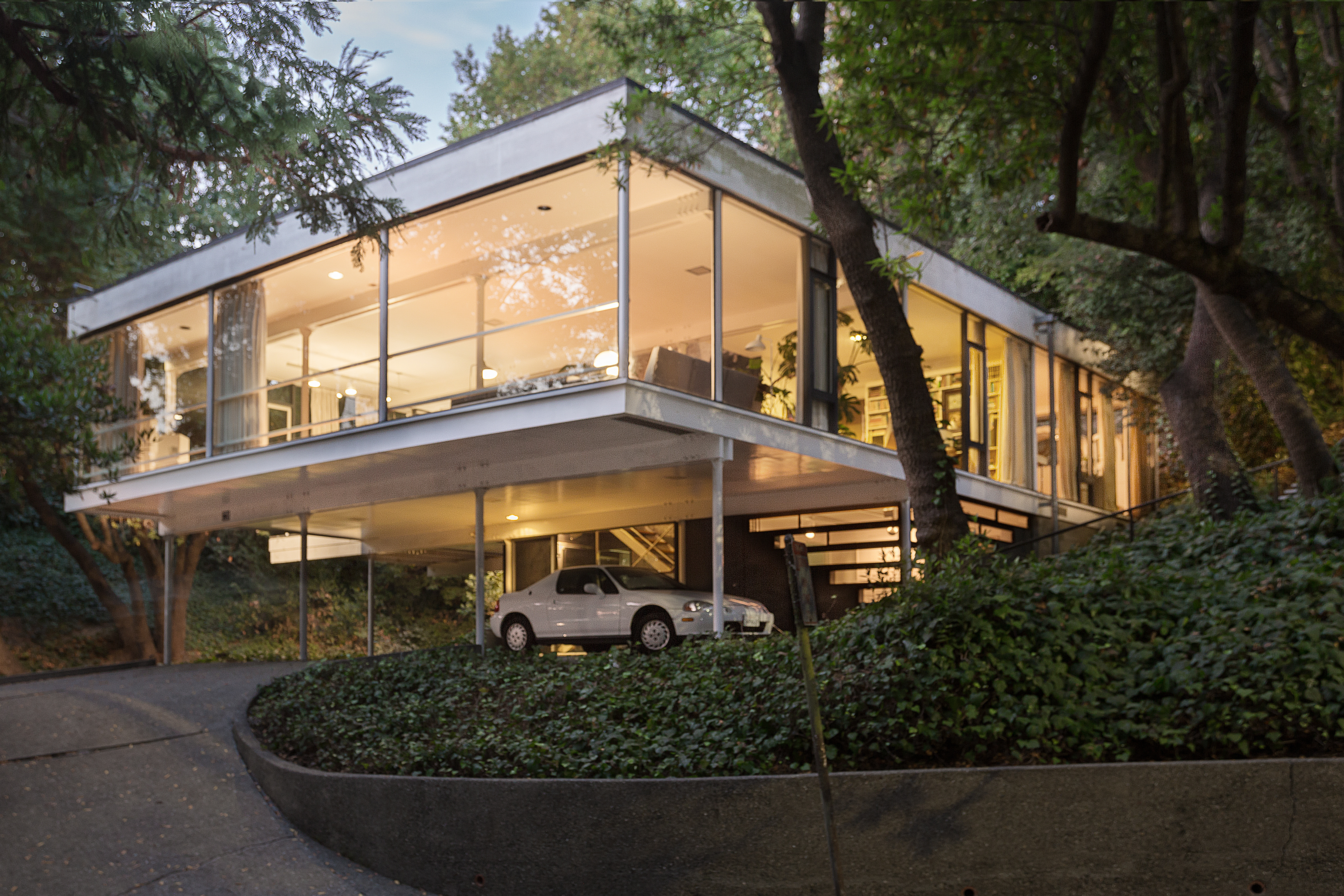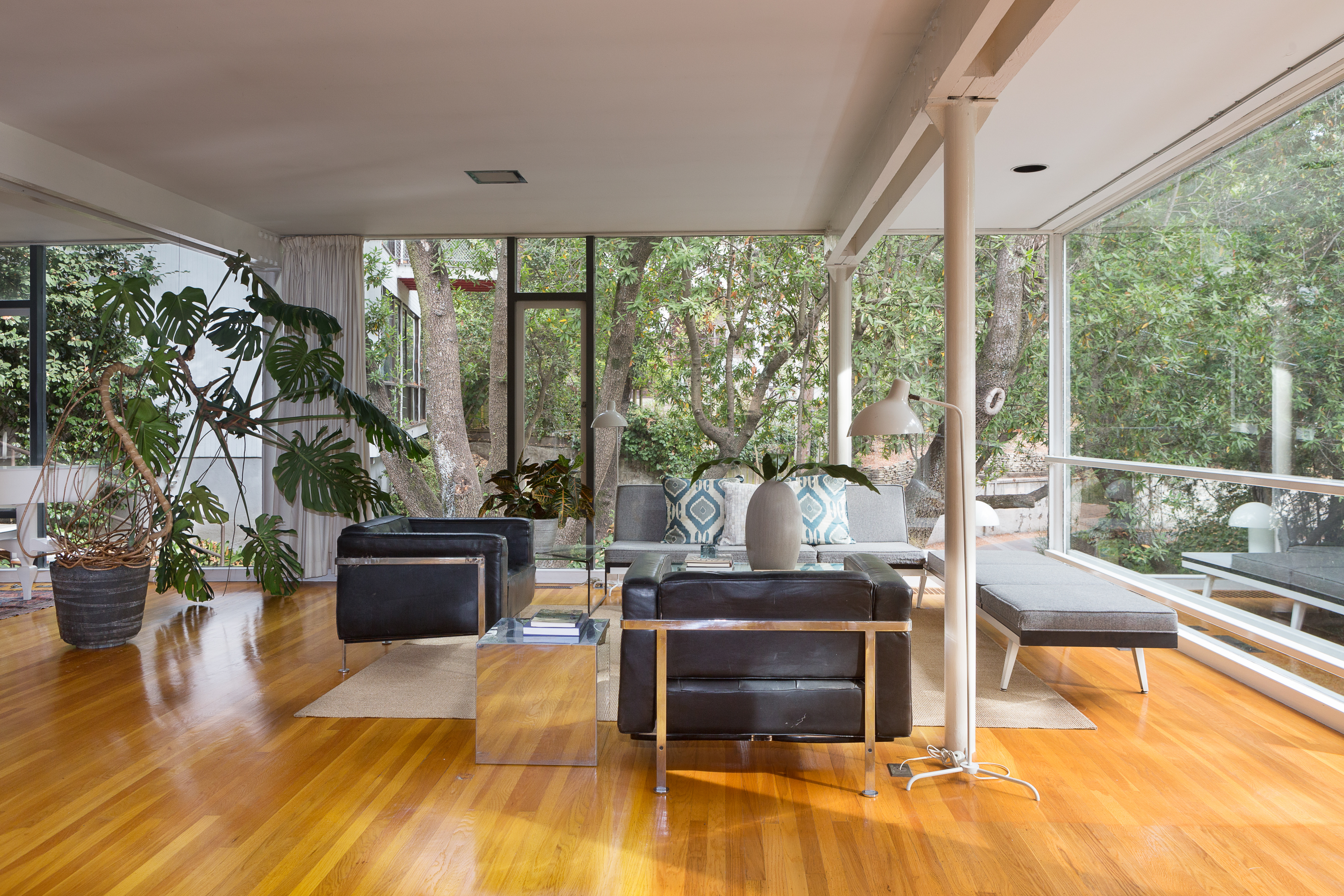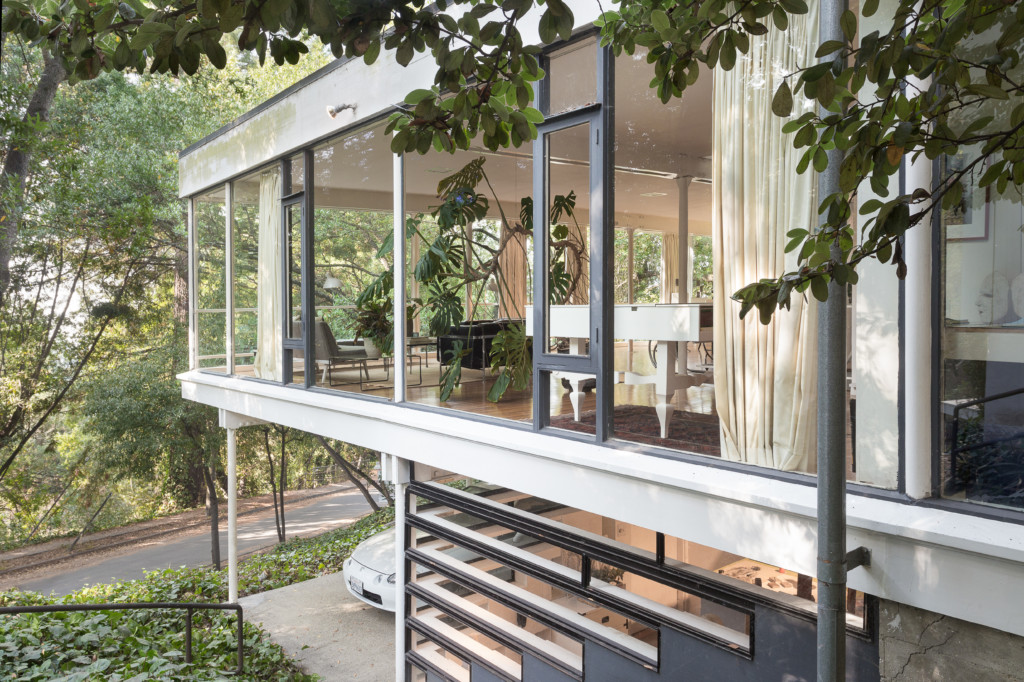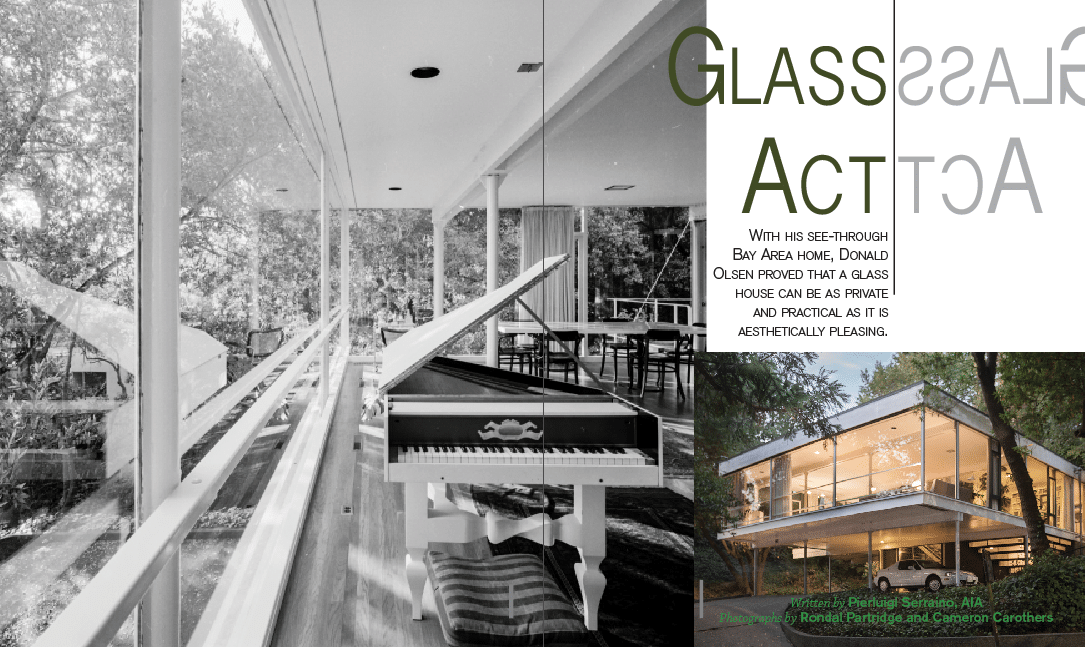With his see-through Bay Area home, Donald Olsen proved that a glass house can be as private and practical as it is aesthetically pleasing.
by Pierluigi Serraino, AIA
Mies Van Der Rohe may have coined the architectural aphorism, “Less Is More,” but it didn’t stop him from living in an unremarkable apartment on a historic block in downtown Chicago. Likewise, the equally celebrated Finnish-American architect, Eero Saarinen made a standard Victorian his home in Bloomfield Hills, Michigan, despite being at the forefront of all things modern in the mid-twentieth century. So it’s the rare architect who lives in a house of their own design that exemplifies their unwavering belief in specific architectural and aesthetic ideologies about how space should be articulated for daily living. That’s what makes the personal home of Donald Olsen in North Berkeley, California such a gem.
Beyond its evident architectural merit, its exceptionalism is rooted in the site and pedigree of its designer, a gifted maverick trained at the Harvard Graduate School of Design directly under Walter Gropius, co-founder (with Mies) of the Bauhaus School in Germany and a major pioneer of modernism. But what is perhaps most compelling about this residence is the way it can be seen equally as a great piece of art as well as a practical environment for domestic living. Olsen and his wife, Helen, lived there for over 60 years, raised a family there, and entertained actively there throughout their lifetime, proving that a space can accommodate both day-to-day functionality as well as make a decisive architectural statement that reflects the orthodoxy of the modern movement.
Completed in 1954, the Olsen Residence sits on a very steep, irregular lot. Yet, thanks to such challenging grading, the sharp incline of the driveway and the abrupt site contour in the back of the property became key factors in determining the exact position of the house. And because of the site’s high elevation from the street below and the thick foliage surrounding it, the inhabitants are afforded an unusual degree of privacy despite its openness.

Set on stilts, the glass house (which is glazed on all four sides) has both a commanding and welcoming presence often foreign to designs fitting the International Style idiom. It follows, almost verbatim, four of the five principles Le Corbusier outlined in his seminal 1923 book Vers Une Architecture: A house on pilotis; free design of the plan; free design of the façade; and ribbon windows. These same architectural ideals can also be found in Mies’ Villa Savoye in Poissy, France, which the Swiss-French master designed in 1929. Much like that masterpiece, the main level of the square-shaped Olsen Residence is located at the center of the second floor. And true to the spirit of the modernist European avant-garde of the twenties and thirties, it is entirely painted white, both inside and out.
There is an invisible perpendicular axis at the house center where the architectural staircase is located. It is the only point in the interiors where one can experience the full height of the building section. Upon entering the small vestibule, the ascent toward the main level reveals a double height mural by American-born artist Claire Falkenstein (who was Paris-based at the time), a personal friend of the Olsens, who commissioned the artwork specifically for their home. Long, narrow clerestory windows on all four sides of a raised light well top this core, illuminating the large painting as well as the areas farthest from the windows. The mural, shipped from Europe and rolled out in Berkeley, was laid out per the artist’s specifications.
All circulation pivots around this center, thus reducing the amount of corridor to an absolute minimum and maximizing the net areas of the building’s footprint. The house derives a sense of grandeur from the clarity of its plan and the intelligibility of its organization, which compensate for its rather modest size: 1,800 square feet cleverly utilized with no wasted space. Two thirds of the main floor are devoted to the kitchen/dining area, a very spacious living room, and an office area, all visually connected as part of an open-plan concept, yet virtually subdivided by the position of the central stair. The sleeping quarters are in the back facing lush greenery and a creek. Its structure is made by sixteen three-and-a-half inch steel pipes laid out on nine bays on a square grid; the horizontal framing is made from a double wood joist anchored to the vertical supports to produce a “moment frame,” structural connections at the corners that help resist seismic movement.

There are three additions to the original plan, all designed by the architect and executed by his son, Alan Olsen. Two long and narrow decks, initially at the front and back of the house, were enclosed in 1963 to increase the square footage. The lower level, a carport when the house was completed, was partially enclosed in 1994 and converted into a studio for Mrs. Olsen’s love of painting. And lastly, in 2003 a small bathroom was added to this level. But the basic organization of the house has remained unchanged.
The central-plan solution with a light well at the center was adopted in numerous designs Olsen did over the years and became his hallmark in the first phase of his career. The legendary magazine Arts & Architecture featured many of his designs and this house appeared a few years after its completion in the July 1960 issue.
Making a virtue of unbuildable lots is a forte of California modernism. It was Helen Olsen who spotted the site while cruising in her car around the hills, at a time in the early fifties when North Berkeley already lacked more viable building sites. That unfavorable condition was turned into an asset by taking advantage of the drastic change of elevation; the height afforded 180-degree views of the San Francisco Bay, which are no longer available due to the mature vegetation surrounding the house (which at least offers an unusual degree of privacy for a glass house).

This metaphorical temple of modernity stands between two other designs by Olsen. On the east side, the Kip House, built in 1952, is a split-level scheme devised for a professor of physics at UC Berkeley; and on the west side, the multilevel Shoebring House, built a few years later, provides another iteration of Olsen’s design language when dealing with comparably difficult site conditions. Taken together, these three buildings produce a truly unique result: An unlikely fragment of a modernist utopia in the epicenter of California regionalism.
Still, it comes as no surprise that the name of Donald Olsen is not well known today, even to the growing mass of mid-century modern aficionados (though curiously, at the time, the architect was a staunch defender of European modernism in local northern California circles). Architect William Wurster, dean of the architecture school at UC Berkeley from 1950 to 1963, routinely introduced Olsen, then on the faculty, as “the other point of view” within the academic elite. To his credit, Olsen never allowed himself to be derailed from his passion for modernism, even during the long post-modernist years.
Born in Minneapolis, Minnesota, he received his architectural indoctrination at the University of Minnesota, where much of the literature on modernism was mainstreamed into general design courses long before the movement caught on at Ivy League colleges. Graduating in 1942, he found employment at the Kaiser Shipyard in Richmond, California, where he witnessed the extraordinary might of the military industrial complex at the start of World War II. By his own admission, Olsen created more designs in the three years he was at the Kaiser Shipyards than in the rest of his career. And it was there that he met many of the architects and engineers who contributed to the mythology of mid-century design. One among them was J.J. Polivka, the structural engineer for Frank Lloyd Wright on the unbuilt San Francisco Bridge, as well as Wright’s celebrated Guggenheim Museum in New York.
As the war ended, Olsen enrolled at Harvard and graduated in 1946. His teachers there included Marcel Breuer, Hugh Stubbins, Joseph Hudnut, and the young I.M. Pei. And among his classmates was Harry Seidler, arguably the most famed Australian architect of his day. It was through Gropius that he found his first job working for Eero Saarinen, who was looking for young talent to join his staff. Olsen was hired as a designer in the offices of Saarinen, Swanson, Saarinen in Bloomfield Hills, Michigan, where he worked on the Drake University dormitories and, to a lesser extent, the General Motors Technical Center in Warren, Michigan.

Following that, he moved back to the San Francisco Bay Area, where he worked for Anshen + Allen, known for their iconic Eichler homes. There, he designed several large service stations. Soon after, he moved on to the offices of Franklin, Kump & Falk, which exposed him to school planning; Skidmore, Owings & Merrill where he learned about health-care design; and finally, Wurster, Bernardi & Emmons, where he specialized in residential work before starting his own practice.
Interestingly, the professional trajectory of Donald Olsen was powered by his alliances with a veritable Who’s Who of the post-war academic elite. While at Harvard, he developed close ties with William Wurster, then at M.I.T., and his wife, Catherine Bauer. Also part of that circle was Vernon DeMars, who directed a student research project at M.I.T. that led to faculty housing project that which Architectural Record called one of the 50 most significant buildings in the United States over the past century.
Together, they formed a core group of professors in the architecture program at UC Berkeley. Wurster, who was named dean of the UC Berkeley architecture school in 1950, hired Olsen over the phone. Three years later, he attended the Congrès Internationux d’Architecture Moderne (CIAM) held in Aix-en-Provence, where he met Alison and Peter Smithson, John Winter, and many other English modernists. In the course of his career, he also met Mies Van der Rohe, Finnish architect Alvar Aalto, Frank Lloyd Wright, and Le Corbusier. Olsen also nurtured friendships with figures who were lesser known to the general public, yet equally important in his own itinerary as an architect, such as Paul Nelson, Hans Scharoun, Ralph Rapson, Serge Chermayeff, and Ralph Jenkins. Together, these associations reflected the complete ideological commitment of Olsen, who became, in turn, a much-beloved teacher to many younger architectural practitioners graduating from Berkeley.
At UC Berkeley, where he taught for 35 years (and where he laid down the schematic design for Wurster Hall), Olsen became a cherished mentor to many and a chief figure in the educational itinerary of numerous notable contemporary graduates. These include city planner and urban designer John Kriken of Skidmore, Owings & Merrill, who has worked on projects in Beijing and Ho Chi Minh City, as well as San Francisco, and Craig Hodgetts of Hodgetts + Fung, who created the new acoustical shell for the Hollywood Bowl and renovated the landmark Egyptian Theater in Hollywood, besides being the founding dean of the School of Design at the California Institute of the Arts.
As a result, the Olsen house was a regular destination for both his students and many brilliant architects visiting the Bay Area, including Pritzker Prize winners Richard Meier and Richard Rogers. In many respects, however, his true model for reforming the culture of design in the Bay Area was always Walter Gropius, with whom Olsen maintained a relationship throughout the rest of the elder architect’s life (he died in 1969).
While he may have been a maverick in his work, Olsen remained married to Helen from their wedding day in 1942 till their deaths—he at 95 in 2015, she at 100. And they always welcomed visitors to their home, forever enjoying and sharing the hypnotic luminosity of this special space, which remains a retreat for contemplation and relaxation. Here, the Olsens marveled at the constant sense of surprise and wonder the house generated while the seasons changed around it. That magic is retained today as moonlight bathes the modernist temple’s interiors and makes way for new owners, promising unforgettable living for generations to come.
Contact us about this property:
Error: Contact form not found.

